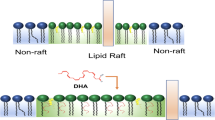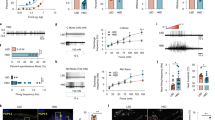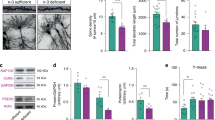Abstract
Although the underlying mechanism remains unknown, several studies have suggested benefits of n-3 long-chain polyunsaturated fatty acid (PUFA) for patients with anxiety disorders. Elevated fear is thought to contribute to the pathogenesis of particular anxiety disorders. The aim of the present study was to evaluate whether the dietary n-3 to n-6 PUFA (3:6) ratio influences fear memory. For this purpose, the effects of various dietary 3:6 ratios on fear memory were examined in mice using contextual fear conditioning, and the effects of these diets on central synaptic transmission were examined to elucidate the mechanism of action of PUFA. We found that fear memory correlated negatively with dietary, serum, and brain 3:6 ratios in mice. The low fear memory in mice fed a high 3:6 ratio diet was increased by the cannabinoid CB1 receptor antagonist rimonabant, reaching a level seen in mice fed a low 3:6 ratio diet. The agonist sensitivity of CB1 receptor was enhanced in the basolateral nucleus of the amygdala (BLA) of mice fed a high 3:6 ratio diet, compared with that of mice fed a low 3:6 ratio diet. Similar enhancement was induced by pharmacological expulsion of cholesterol in the neuronal membrane of brain slices from mice fed a low 3:6 ratio diet. CB1 receptor-mediated short-term synaptic plasticity was facilitated in pyramidal neurons of the BLA in mice fed a high 3:6 ratio diet. These results suggest that the ratio of n-3 to n-6 PUFA is a factor regulating fear memory via cannabinoid CB1 receptors.
Similar content being viewed by others
Log in or create a free account to read this content
Gain free access to this article, as well as selected content from this journal and more on nature.com
or
References
Bari M, Battista N, Fezza F, Finazzi-Agro A, Maccarrone M (2005a). Lipid rafts control signaling of type-1 cannabinoid receptors in neuronal cells. J Biol Chem 280: 12212–12220.
Bari M, Oddi S, De Simone C, Spagnolo P, Gasperi V, Battista N et al (2008). Type-1 cannabinoid receptors colocalize with caveolin-1 in neuronal cells. Neuropharmacology 54: 45–50.
Bari M, Paradisi A, Pasquariello N, Maccarrone M (2005b). Cholesterol-dependent modulation of type 1 cannabinoid receptors in nerve cells. J Neurosci Res 81: 275–283.
Cuthbert BN, Lang PJ, Strauss C, Drobes D, Patrick CJ, Bradley MM (2003). The psychophysiology of anxiety disorder: fear memory imagery. Psychophysiology 40: 407–422.
Debiec J, LeDoux JE (2006). Noradrenergic signaling in the amygdala contributes to the reconsolidation of fear memory: treatment implications for PTSD. Ann N Y Acad Sci 1071: 521–524.
Green P, Hermesh H, Monselise A, Marom S, Presburger G, Weizman A (2006). Red cell membrane omega-3 fatty acids are decreased in nondepressed patients with social anxiety disorder. Eur Neuropsychopharmacol 16: 107–113.
Horrocks LA, Farooqui AA (2004). Docosahexaenoic acid in the diet: its importance in maintenance and restoration of neuronal membrane function. Prostaglandins Leukot Essent Fatty Acids 70: 361–372.
Jacka FN, Pasco JA, Williams LJ, Meyer BJ, Digger R, Berk M (2013). Dietary intake of fish and PUFA, and clinical depressive and anxiety disorders in women. Br J Nutr 109: 2059–2066.
Kano M, Ohno-Shosaku T, Hashimotodani Y, Uchigashima M, Watanabe M (2009). Endocannabinoid-mediated control of synaptic transmission. Physiol Rev 89: 309–380.
Lafourcade M, Larrieu T, Mato S, Duffaud A, Sepers M, Matias I et al (2011). Nutritional omega-3 deficiency abolishes endocannabinoid-mediated neuronal functions. Nat Neurosci 14: 345–350.
Larrieu T, Madore C, Joffre C, Layé S (2012). Nutritional n-3 polyunsaturated fatty acids deficiency alters cannabinoid receptor signaling pathway in the brain and associated anxiety-like behavior in mice. J Physiol Biochem 68: 671–681.
LeDoux JE (2000). Emotion circuits in the brain. Annu Rev Neurosci 23: 155–184.
Lepage G, Roy CC (1986). Direct transesterification of all classes of lipids in a one-step reaction. J Lipid Res 27: 114–120.
Lisboa SF, Reis DG, da Silva AL, Correa FMA, Guimaraes FS, Resstel LBM (2010). Cannabinoid CB1 receptors in the medial prefrontal cortex modulate the expression of contextual fear conditioning. Int J Neuropsychopharmacol 13: 1163–1173.
Maccarrone M, De Chiara V, Gasperi V, Viscomi MT, Rossi S, Oddi S et al (2009). Lipid rafts regulate 2-arachidonoylglycerol metabolism and physiological activity in the striatum. J Neurochem 109: 371–381.
Mackowiak M, Chocyk A, Dudys D, Wedzony K (2009). Activation of CB1 cannabinoid receptors impairs memory consolidation and hippocampal polysialylated neural cell adhesion molecule expression in contextual fear conditioning. Neuroscience 158: 1708–1716.
Marsicano G, Wotjak CT, Azad SC, Bisogno T, Rammes G, Cascio MG et al (2002). The endogenous cannabinoid system controls extinction of aversive memories. Nature 418: 530–534.
Matsuoka Y, Nishi D, Yonemoto N, Hamazaki K (2010). Omega-3 fatty acids for secondary prevention of posttraumatic stress disorder after accidental injury an open-label pilot study. J Clin Psychopharmacol 30: 217–219.
Milad MR, Rauch SL, Pitman RK, Quirk GJ (2006). Fear extinction in rats: implications for human brain imaging and anxiety disorders. Biol Psychol 73: 61–71.
Nishi D, Koido Y, Nakaya N, Sone T, Noguchi H, Hamazaki K et al (2012). Fish oil for attenuating posttraumatic stress symptoms among rescue workers after the great east Japan earthquake: a randomized controlled trial. Psychother Psychosom 81: 315–317.
Oddi S, Dainese E, Fezza F, Lanuti M, Barcaroli D, De Laurenzi V et al (2011). Functional characterization of putative cholesterol binding sequence (CRAC) in human type-1 cannabinoid receptor. J Neurochem 116: 858–865.
O’Donnell T, Hegadoren KM, Coupland NC (2004). Noradrenergic mechanisms in the pathophysiology of post-traumatic stress disorder. Neuropsychobiology 50: 273–283.
Ohno-Shosaku T, Tsubokawa H, Mizushima I, Yoneda N, Zimmer A, Kano M (2002). Presynaptic cannabinoid sensitivity is a major determinant of depolarization-induced retrograde suppression at hippocampal synapses. J Neurosci 22: 3864–3872.
Pamplona FA, Prediger RDS, Pandolfo P, Takahashi RN (2006). The cannabinoid receptor agonist WIN 55,212-2 facilitates the extinction of contextual fear memory and spatial memory in rats. Psychopharmacology 188: 641–649.
Pamplona FA, Takahashi RN (2006). WIN55,212-2 impairs contextual fear conditioning through the activation of CB1 cannabinoid receptors. Neurosci Lett 397: 88–92.
Rauch SL, Shin LM, Phelps EA (2006). Neurocircuitry models of posttraumatic stress disorder and extinction: human neuroimaging research—past, present, and future. Biol Psychiatry 60: 376–382.
Reeves PG, Nielsen FH, Fahey GC (1993). AIN-93 purified diets for laboratory rodents: final report of the American institute of nutrition ad hoc writing committee on the reformulation of the AIN-76A rodent diet. J Nutr 123: 1939–1951.
Resstel LBM, Lisboa SF, Aguiar DC, Correa FMA, Guimaraes FS (2008). Activation of CB1 cannabinoid receptors in the dorsolateral periaqueductal gray reduces the expression of contextual fear conditioning in rats. Psychopharmacology 198: 405–411.
Rinaldi-Carmona M, Barth F, Héaulme M, Shire D, Calandra B, Congy C et al (1994). SR141716A, a potent and selective antagonist of the brain cannabinoid receptor. FEBS Lett 350: 240–244.
Sakurai M, Sekiguchi M, Zushida K, Yamada K, Nagamine S, Kabuta T et al (2008). Reduction in memory in passive avoidance learning, exploratory behaviour and synaptic plasticity in mice with a spontaneous deletion in the ubiquitin C-terminal hydrolase L1 gene. Eur J Neurosci 27: 291–701.
Salem N Jr, Niebylski CD (1995). The nervous system has an absolute molecular species requirement for proper function. Mol Mem Biol 12: 131–134.
Sarnataro D, Grimaldi C, Pisanti S, Gazzerro P, Laezza C, Zurzolo C et al (2005). Plasma membrane and lysosomal localization of CB1 cannabinoid receptor are dependent on lipid rafts and regulated by anandamide in human breast cancer cells. FEBS Lett 579: 6343–6349.
Sarter M, Bodewitz G, Stephens DN (1988). Attenuation of scopolamine-induced impairment of spontaneous alteration behaviour by antagonist but not inverse agonist and agonist beta-carbolines. Psychopharmacology (Berl) 94: 491–495.
Sink KS, Segovia KN, Collins LE, Markus EJ, Vemuri VK, Makriyannis A et al (2010). The CB1 inverse agonist AM251, but not the CB1 antagonist AM4113, enhances retention of contextual fear conditioning in rats. Pharmacol Biochem Behav 95: 479–484.
Stillwell W, Wassall SR (2003). Docosahexaenoic acid: membrane properties of a unique fatty acid. Chem Phys Lipids 126: 1–27.
Stillwell W, Shaikh SR, Zerouga M, Siddiqui R, Wassall SR (2005). Docosahexaenoic acid affects cell signaling by altering lipid rafts. Reprod Nutr Dev 45: 559–579.
Shaikh SR, Cherezov V, Caffrey M, Soni SP, LoCascio D, Stillwell W et al (2006). Molecular organization of cholesterol in unsaturated phosphatidylethanolamines: X-ray diffraction and solid state 2H NMR reveal differences with phosphatidylcholines. J Am Chem Soc 128: 5375–5383.
Takeuchi T, Iwanaga M, Harada E (2003). Possible regulatory mechanism of DHA-induced anti-stress reaction in rats. Brain Res 964: 136–143.
Wassall SR, Stillwell W (2008). Docosahexaenoic acid domains: the ultimate non-raft membrane domain. Chem Phys Lipids 153: 57–63.
Yamada D, Zushida K, Wada K, Sekiguchi M (2009). Pharmacological discrimination of extinction and reconsolidation of contextual fear memory by a potentiator of AMPA receptors. Neuropsychopharmacology 34: 2574–2584.
Yamada D, Miyajima M, Ishibashi H, Wada K, Seki K, Sekiguchi M (2012). Adult-like action potential properties and abundant GABAergic synaptic responses in amygdala neurons from newborn marmosets. J Physiol 590: 5691–5706.
Yang X, Sheng W, Sun GY, Lee JC-M (2011). Effects of fatty acid unsaturation numbers on membrane fluidity and α-secretase-dependent amyloid precursor protein processing. Neurochem Int 58: 321–329.
Yoshida T, Uchigashima M, Yamasaki M, Katona I, Yamazaki M, Sakimura K et al (2011). Unique inhibitory synapse with particularly rich endocannabinoid signaling machinery on pyramidal neurons in basal amygdaloid nucleus. Proc Natl Acad Sci USA 108: 3059–3064.
Youdim KA, Martin A, Joseph JA (2000). Essential fatty acids and the brain: possible health implications. Int J Dev Neurosci 18: 383–399.
Zádor F, Otvos F, Benyth S, Zimmer Z, Paldy E (2012). Inhibition of forebrain mu-opioid receptor signaling by low concentrations of rimonabant does not require cannabinoid receptors and directly involves mu-opioid receptors. Neurochem Int 61: 378–388.
Zushida K, Sakurai M, Wada K, Sekiguchi M (2007). Facilitation of extinction learning for contextual fear memory by PEPA: a potentiator of AMPA receptors. J Neurosci 27: 158–166.
Acknowledgements
We thank Drs Takao Shimizu, Shuh Narumiya and Masanobu Kano for their helpful advice on our work. We also thank Drs Yoshihiro Kita and Suzumi Tokuoka for discussion. We thank Wakako Seki for her help in the lipid analysis.
Author information
Authors and Affiliations
Corresponding author
Additional information
Supplementary Information accompanies the paper on the Neuropsychopharmacology website
Rights and permissions
About this article
Cite this article
Yamada, D., Takeo, J., Koppensteiner, P. et al. Modulation of Fear Memory by Dietary Polyunsaturated Fatty Acids via Cannabinoid Receptors. Neuropsychopharmacol 39, 1852–1860 (2014). https://doi.org/10.1038/npp.2014.32
Received:
Revised:
Accepted:
Published:
Issue date:
DOI: https://doi.org/10.1038/npp.2014.32
Keywords
This article is cited by
-
Maternal dietary imbalance between omega-6 and omega-3 fatty acids triggers the offspring’s overeating in mice
Communications Biology (2020)
-
Stress induces insertion of calcium-permeable AMPA receptors in the OFC–BLA synapse and modulates emotional behaviours in mice
Translational Psychiatry (2020)
-
Recent trends in mental illness and omega-3 fatty acids
Journal of Neural Transmission (2020)
-
Integrating Endocannabinoid Signaling and Cannabinoids into the Biology and Treatment of Posttraumatic Stress Disorder
Neuropsychopharmacology (2018)



